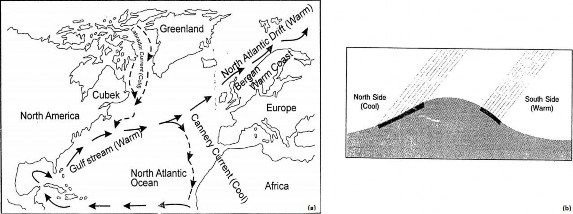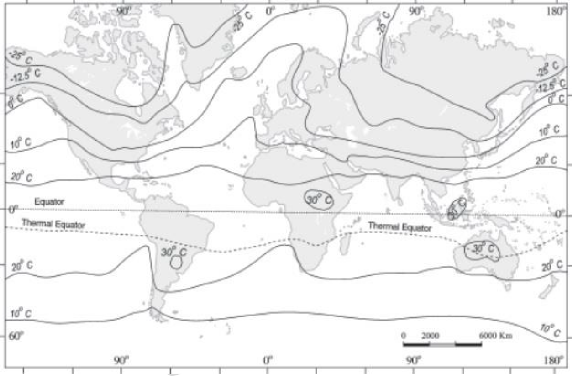(a) – effect of altitude (b) – maritime influence Figure 6 – effect of altitude & distance from sea on temperature

Figure 7 – (a) effect of ocean currents & (b) effect of slope on temperature
4. Ocean Currents: the effect of warm ocean currents and the cold ocean currents is limited to the adjoining coastal areas. The warm ocean currents flow along the eastern coast of tropical and sub-tropical regions and western coast of higher latitudes. On the other hand, cold ocean currents flow along the eastern coast of higher latitude and along the western coast of tropical and sub-tropical areas. The North Atlantic drift, an extension of Gulf Stream, warm the coastal districts of Western Europe (such as Norway) and British Isles keeping their ports ice-free (figure 7(a)).

5. Air-mass circulation: air masses in form of winds helps in the redistribution of temperature. The places, which come under the influence of warm air-masses experience higher temperature and the places that come under the influence of cold air masses experience low temperature. The effect of these winds is, however, limited to the period during which they blow. Local winds like cold Mistral of France considerably lower the temperature and Sirocco, a hot wind that blows from Sahara desert raises the temperature of Italy, Malta etc.
The temperature rises at the time of arrival of temperate cyclones, while it falls sharply after their passage. Sometimes, local winds can cause sudden change in temperature. In northern India, ‘Loo’, a local hot wind, raise the temperature to such an extent that heat waves prolong for several days in continuation and many people die of sunstroke.
6. Slope, Shelter and aspect: slopes of a mountain facing the Sun experiences high temperature than the slopes on the leeward side due to more insolation (figure 7(b)). A steep slope experiences a more rapid change in temperature than a gentle one. Mountain ranges that have an east-west alignment like the Alps show a higher temperature on the south-facing ‘sunny slope’ than the north facing ‘sheltered slope’. Consequently, there are more settlements in southern side and it is better utilized for agricultural and other purposes.
The mountain ranges at certain places stop the cold winds and prevent the temperature from going down. This is found in areas where mountains lie in the direction facing the winds as in the case of Himalayas. In the absence of Himalayas, winters of India would have been very different.
7. Nature of ground surface: the nature of surface in terms of colour, vegetation, soil, land use, snow cover etc. affects the temperature of a place. In the tropical and subtropical deserts, the sandy surface record high temperature because they absorb most of the solar radiations. Snow has very high albedo6 and thus, reflects much of the insolation without absorption. Thick vegetation (such as Amazon forest) cuts off much of the in-coming insolation and in many places sunlight never reaches the ground. It is cool in the jungle and its shade temperature is a few degrees lower than that of open spaces in corresponding
latitudes. Light soils reflect more heat than darker soils. Dry soils like sands are very sensitive to temperature changes, whereas wet soils, like clay retain much moisture and warm up more slowly. Urban areas have relatively higher temperature than the surrounding.
3.1. Distribution of Temperature
The global distribution of temperature can well be understood by studying the isotherms. The Isotherms are lines joining places having equal temperature. As already discussed, latitudes have pronounced effect on the temperature, the isotherms are generally parallel to the latitude. The deviation from this general trend is more pronounced in January than in July, especially in the northern hemisphere. Figure 8 and 9 show the distribution of surface air temperature in the month of January and July. In the northern hemisphere the land surface area is much larger than in the southern hemisphere. Hence, the effects of land mass and the ocean currents are well pronounced. Following are the chief features of isotherms:

